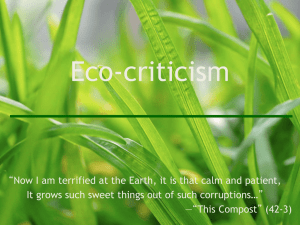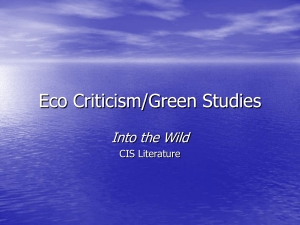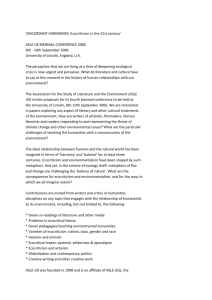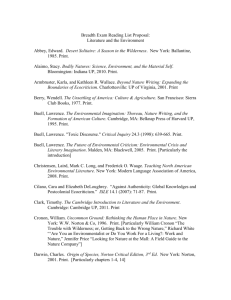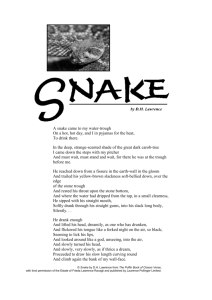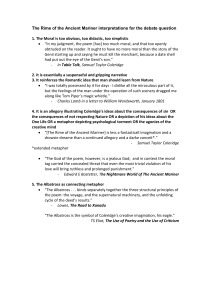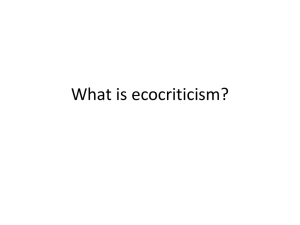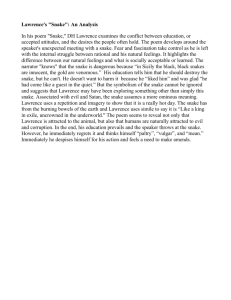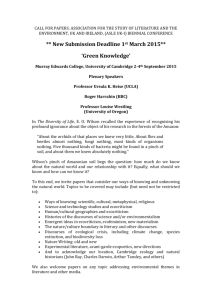1 - IJELR
advertisement
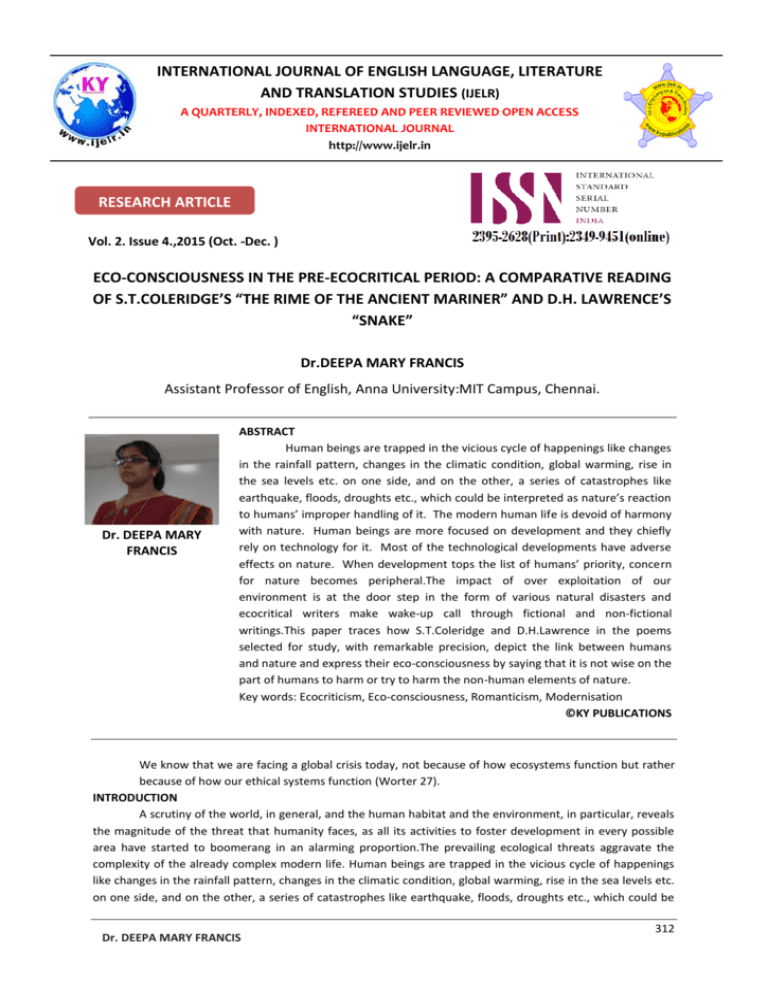
INTERNATIONAL JOURNAL OF ENGLISH LANGUAGE, LITERATURE Int.J.Eng.Lang.Lit&Trans.StudiesVol.2.Issue. 4.2015 (Oct-Dec) AND TRANSLATION STUDIES (IJELR) A QUARTERLY, INDEXED, REFEREED AND PEER REVIEWED OPEN ACCESS INTERNATIONAL JOURNAL http://www.ijelr.in KY PUBLICATIONS RESEARCH ARTICLE Vol. 2. Issue 4.,2015 (Oct. -Dec. ) ECO-CONSCIOUSNESS IN THE PRE-ECOCRITICAL PERIOD: A COMPARATIVE READING OF S.T.COLERIDGE’S “THE RIME OF THE ANCIENT MARINER” AND D.H. LAWRENCE’S “SNAKE” Dr.DEEPA MARY FRANCIS Assistant Professor of English, Anna University:MIT Campus, Chennai. Dr. DEEPA MARY FRANCIS ABSTRACT Human beings are trapped in the vicious cycle of happenings like changes in the rainfall pattern, changes in the climatic condition, global warming, rise in the sea levels etc. on one side, and on the other, a series of catastrophes like earthquake, floods, droughts etc., which could be interpreted as nature’s reaction to humans’ improper handling of it. The modern human life is devoid of harmony with nature. Human beings are more focused on development and they chiefly rely on technology for it. Most of the technological developments have adverse effects on nature. When development tops the list of humans’ priority, concern for nature becomes peripheral.The impact of over exploitation of our environment is at the door step in the form of various natural disasters and ecocritical writers make wake-up call through fictional and non-fictional writings.This paper traces how S.T.Coleridge and D.H.Lawrence in the poems selected for study, with remarkable precision, depict the link between humans and nature and express their eco-consciousness by saying that it is not wise on the part of humans to harm or try to harm the non-human elements of nature. Key words: Ecocriticism, Eco-consciousness, Romanticism, Modernisation ©KY PUBLICATIONS We know that we are facing a global crisis today, not because of how ecosystems function but rather because of how our ethical systems function (Worter 27). INTRODUCTION A scrutiny of the world, in general, and the human habitat and the environment, in particular, reveals the magnitude of the threat that humanity faces, as all its activities to foster development in every possible area have started to boomerang in an alarming proportion.The prevailing ecological threats aggravate the complexity of the already complex modern life. Human beings are trapped in the vicious cycle of happenings like changes in the rainfall pattern, changes in the climatic condition, global warming, rise in the sea levels etc. on one side, and on the other, a series of catastrophes like earthquake, floods, droughts etc., which could be Dr. DEEPA MARY FRANCIS 312 Int.J.Eng.Lang.Lit&Trans.StudiesVol.2.Issue. 4.2015 (Oct-Dec) interpreted as nature’s reaction to humans’improper handling of it. Humans are the only species that do things not just to fulfil their need, but to satiate their greed. Our exploration and exploitation of nature and its resources with an unquenchable thirst, have taken us a long way and now there is a distinct realisation that it is high time we think about extending a concern for the flora and fauna as well. Ecocriticism, as a school of thought, pleads for a better understanding of nature and seeks to protect the ecological rights of nature. Aim of the Paper This paper seeks to explore how one of the pioneers of the romantic age, Samuel Taylor Coleridge, in his poem, “The Rime of the Ancient Mariner”,and the modern poet, David HerbertRichards Lawrence, in his poem, “Snake”, express their eco-consciousness out of their love for nature and its non-human elements, during those literary periods when ecocriticism was not seriously thought about. This paper traces how both these poets,with remarkable precision, depict the link between humans and nature and express their ecoconsciousness by saying that it is not wise on the part of humans to harm or try to harm the non-human elements of nature. Both these poets are generally unhappy about the impacts of industrialisation and modernisation on nature. Ecocriticism Ecocriticism is a relatively new school of thought that has gained attention over the last four decades. Any study on ecocriticism remains incomplete without the mention of the name, CheryllGlotfelty, the acknowledged founder of this movement in the USA, who, along with her co-editor, Harold Fromm, published “a key collection of helpful and definitive essays entitled The Ecocriticism Reader: Landmarks in Literary Ecology” (Barry 239). Cheryll is also the co-founder of ASLE (the Association for the Study of Literature and Environment), an association that was formed in 1992 “at the annual meeting of the Western Literature Association” with Scott Slovic as the first President (Cheryll xviii). Coined by William Rueckert in 1978, the term ecocriticism is gaining significance globally as humanity, by and large, faces a lot of threats from nature, which are the consequences of humans’ egalitarian attitude and people from diverse fronts are writing about the threats and thinking about the possible ways and means to keep the exploitation of nature and the damage caused to the environment in check. Literary theory chiefly examines the relation among writers, texts and the world. The general understanding about the interpretation of the term ‘the world’ in most of the literary theories is society – the social sphere. But ecocriticism expands the notion of ‘the world’ to include the entire ecosphere. Ecocriticism encompasses the study of subjects like science, literature, anthropology, sociology, psychology etc. and therefore, ecocriticism, as a school of thought, is not confined only within the limitations of literary field, but it has also gained expression in other related fields of study. Ecocriticism opens the chance for us to examine ourselves and the world around us, appraising the way that we represent and interact with the environment, both natural and artificially created. Ecocriticism, to put it in the words of Richard Kerridge, “seeks to evaluate texts and ideas in terms of their coherence and usefulness as responses to environmental crisis” (qtd. Gersdorf 11). To go by the words of CheryllGlotfelty, “ecocriticism is the study of the relationship between literature and the physical environment” (xviii). The presence of a bond between the human and the non-human generally forms the ecocritical basis of a text. Ecocriticism voices a better understanding of nature and represents the natural world. Ecocriticism, as a movement, still does not have a widely-known set of assumptions, doctrines or procedures. Representation of the natural environment in literature is as old as recorded literature. An attempt to trace the origin of the description of the natural environment will take any researcher to the description of the Garden of Eden in the Hebrew Bible. Creative writers have been describing the beauty of nature since 300 BC and the writings of Theocritus bear testimony to this fact. As stated earlier, the US is the birth place of ecocriticism as a school of thought. Peter Barry in Beginning Theorysays, “Ecocriticism, as it now exists in the USA, takes its literary bearings from three major nineteenth-century American writers whose work celebrates nature, the life force, and the wilderness as manifested in America, these being Ralph Waldo Emerson (18031882), Margaret Fuller (1810-1850), and Henry David Thoreau (1817-1862)” (240). He goes on to say how ecocriticism took shape in the UK. He says, “By contrast, the UK version of ecocriticism, or green studies, takes its bearings from the British Romanticism of the 1790s” (241). Hubert Zapf in his essay, “The State of Dr. DEEPA MARY FRANCIS 313 Int.J.Eng.Lang.Lit&Trans.StudiesVol.2.Issue. 4.2015 (Oct-Dec) Ecocriticism and the Function of Literature as Cultural Ecology”, rightly traces how the British writers since the romantic age are very much drawn towards nature and how they give expression to their ecocritical thoughts in their works of art. He says, Since the era of romanticism, of course, that is to say since the first sustained response of literature to the era of beginning modernization[sic], this affinity of literary and ecological concerns has become more and more explicit, and has led, in the 20th century, to the emergence of various forms of environmental literature, of nature writing, of ecologically inspired art, poetry, and fiction (55). Introduction of the Poets The occidental poets chosen here for study are historically divided by a century, but the modern poet in question has taken almost an equal stand with the romantic poet in expressing the need to have a shift from anthropocentric outlook to biocentric or ecocentric attitude. Samuel Taylor Coleridge (1772 – 1834), an English poet, literary critic and philosopher, joined hands with his friend, William Wordsworth, to mark the dawn of the romantic movement in England, with the publication of their work Lyrical Balladsand ‘The Rime of the Ancient Mariner’ was one of the poems of that collection. It is the longest poem in the collection and gained considerable attention even at that time. D. H. Lawrence (1885-1930), an English novelist, poet, playwright, essayist, literary critic and painter, has said a lot about the dehumanizing effects of modernisation and industrialization in his creative works. He has a unique position among the writers of the first half of the twentieth century. Lawrence’s poem “Snake” was published in his poetry collection titled Birds, Beasts and Flowers in the year 1923. The title of the collection is so expressive of the subject matters of the poems of this collection. The poem “Snake” is a cleardemonstrationof Lawrence’s skill to translate his experience into creative work with unique vividness. Both the poems taken here for study centre on the relationship between humans and nature, and explore the incessant and burning issue of man–animal conflict. Coleridge goes a step ahead and portrays the result of any mishandling of elements of nature at its best. These two poems are equally appealing, thanks to the poets’ picturesque description of the emotional and ecocritical aspects. The mention about ‘snake’ in “The Rime of the Ancient Mariner”, of which D. H. Lawrence’s poem is about, and the Mariner’s act of blessing it, and Lawrence’s reference to the albatross, which plays a major role in Coleridge’s poem can be interpreted as the slender thread that connects these two poems. Ecocritical Elements in the Select Poems Even before the advent of the school of ecocriticism, many writers have expressed their concern for nature in their writings. Dr.NirmalSelvamony in the Introduction toEssays in Ecocriticism says, “If exploration of the relation between literature and environment is ecocriticism, then all literature is somehow ecocritical because any poetic subject is ultimately part of the physical or mental environment” (xv).Human beings’ supremacy over nature has started from the Garden of Eden. According to the holy Bible, God created everything and then created man and made him the master of everything. God allowed man to use nature for his survival, but at one point, man forgot the purpose of nature and started to exploit it and that exploitation continues ceaselessly. At a time and age in whichecocritical theory was not conceptualized, S. T. Coleridge, in a distinct manner, has put forth the bitter truth that humanity at times shows a thankless attitude towards nature, which was gifted by God as its source for existence. Coleridge expresses his view that to endanger nature and elements of nature is an activity likened to humanity digging its own grave.In “The Rime of the Ancient Mariner”, the poet deals with the theme of crime and punishment with an unparalleled elegance. The ancient mariner, the raconteur of Coleridge’s story, detains one of the three guests on their way to the wedding house and narrates the tale of his expedition to the South. When the mariner’s ship gets struck in the snow covered sea, the Albatross comes as a good omen. The sailors cheer at the sight of it. “As if it had been a Christian soul,/ We hail’d it in God’s name” (3).After the arrival of the albatross, the ice splits and makes way for the ship. But the mariner’s killing of the albatross is a gesture of ingratitude and his sufferings start from there. The situation of being held in the deep sea with water surrounding the ship but with no water to drink translates itself to the present situation of depleting water level in the land though all the continents are bordered by oceans. The recent changes in the climate have resulted in the depletion of surface and ground Dr. DEEPA MARY FRANCIS 314 Int.J.Eng.Lang.Lit&Trans.StudiesVol.2.Issue. 4.2015 (Oct-Dec) water in many areas. Even in a flooded situation, humans face the same crisis as said by Coleridge, “Water, water, everywhere,/And all the boards did shrink;/ Water, water, everywhere,/Nor any drop to drink.”(5). With too much of pollution, mankind is slowly losing the privilege of getting pure water to drink, and clean and fresh air to breathe. All his fellow sailors, “Four times fifty living men”, die and he is left alone to face the music of his thankless activity (9). The poet’s empathetic mind has helped him imagine the catastrophe which would arise as an impact of any serious damage to nature. The catastrophe the mariner faces is nothing other than the apocalypse, which is one of the features getting expressed in some ecocritical works. When he blesses the water-snakes, situation takes a dramatic twist and eventually, he reaches his place. The relieved mariner says, “all in my own countree,/ I stood on the firm land!” (22). Coleridge’s protagonist prudently selects the person to narrate his experience. The mariner says, “I have strange power of speech;/That moment that his face I see,/I know the man that must hear me:/ To him my tale I teach.” (23). He chooses the person who has the prospect of being changed into a person with better thoughts and could think wisely after listening to his experience. By narrating his storyto the person of his choice, he actually teaches that person in order to make him wise so that he will treat nature with the concern it deserves. After listening to the mariner’s experience, the next day, the listener of the story wakes up “sadder” and “wiser”. Coleridge ends his poem with these lines: “A sadder and wiser man/ He rose the morrow morn” (24). Kate Rigby in the essay titled “Romanticism and Ecocriticism” published in The Oxford Handbook of Ecocriticism, says, “the primary foci of ecocritical interest in Romanticism have been the new ways of viewing and valuing, representing and relating to the natural world that emerged during this period” (62). This poem penned by the romantic poet effectively exposes his ecocritical thoughts and is hailed as a benchmark ecocritical work in the pre-ecocritical period. We live in an era in which the forests recede. A good portion of wilderness has been colonised. Most of the urban children are getting to know of pastoral only by watching television or by reading books. The constant escalation of population rate has resulted in over exploitation of nature. Development comes in many forms and serves multiple purposes. When development tops the list of humans’ priority, concern for nature becomes peripheral. Bygone are the days of a friendly partnership between man and nature. Snakes are generally associated with wilderness but they are seen in most places. We have grown up by listening to stories in which snakes are projected as objects not just of fear but also of veneration and even of worship. D. H. Lawrence’s poem “Snake” is about his interesting encounter with a snake. On a hot day, when the poet goes to fill his pitcher, there is a snake to drink water from the trough. The poet has to “stand and wait” allowing the legless creature quench its thirst. The poet’s admiration for the snake makes him recognise the similarity between the snake drinking water and cattle drinking water. About the casual way in which the snake drinks water, the poet writes, “He lifted his head from his drinking, as cattle do, / And looked at me vaguely, as drinking cattle do,” (113). Even snake, which is an element of wilderness and a reptile which instills fear, can do things like domesticated animals. The detailed description of the way the snake drinks water brings to the forefront Lawrence’s keen sense of observation. The poem reflects the poet’s concern for the non-human elements of nature. The education and knowledge acquired by the poet make him realise that in Sicily, the golden coloured snakes are venomous. The educated man in Lawrence wants to strike the snake whereas the nature lover in him admires the snake. Finally, the educated self of the poet wins and he picks up “a clumsy log” and throws “it at the water trough with a clatter”. The snake leaves the spot “in undignified haste” (115). The poet compares the movement of the snake and its quick disappearance with that of lightning. Later, the inner self of the poet repents that he should not have tried to hit the snake which had come to his place as a guest. Lawrence refers to the Mariner’s repenting of killing of the albatross. Snake worship, which prevails in many places, could be interpreted as a part of Nature worship. The Pulluvan Pattu of Kerala is meant to celebrate and worship serpents and is sung “where there is a Nagaraja pradistai… at a temple” (Lalitha and Nandhini). The Sarpa Kaavu in Kerala is a sort of protected wilderness which is believed to be the abode of Serpent God. The trees in such sacred grooves and the pond adjacent to them are revered by people. The ironic convergence of protection and worship of nature on one side and the exploitation and destruction of it on the other has become the order of the day. From ancient times to the present, several Dr. DEEPA MARY FRANCIS 315 Int.J.Eng.Lang.Lit&Trans.StudiesVol.2.Issue. 4.2015 (Oct-Dec) people at numerous times and for innumerable reasons have voiced concerns about the natural world. In an article titled “Protect Tibet from Global Warming” published in The Hindu dated 21/10/15, it was written, “Dalai Lama… urged the world to protect Tibet from global warming, saying his Himalayan homeland was crucial to the health of the world.” Through this poem, the poet makes a fervent appeal to the readers to lead a life without disturbing and damaging nature and its non-human elements. Human beings cannot undo their actions of affecting the environment. The “mean act”, to borrow the words of Lawrence, of humans will go a long way to destroy nature and the immensity of destruction becomes so great that after a particular point nothing could be done to set it right (116). D. H. Lawrence transforms his experience into creative work and that, in turn, into a perspective: the perspective to encompass even the non-human as part and parcel of the human world. Conclusion The infrastructure needs of society, clubbed with its perennial craving to use natural resources for its comfort,are the chief sources of all the threats it faces. Environmental concerns are sacrificed for developmental projects. The impact of over exploitation of our environment is at the door step and ecocritical writers make wake-up call through fictional and non-fictional writings.Despite the disparitiesin the poems selected for study, readers could find marked similarities in these poets’ outlook about nature. When Coleridge with an unparalleled foresight, narrates the consequences of human beings troubling nature, Lawrence, in an equally exceptional fashion, drives home the idea that human beings, the prime creations of God, should extend their care and concern towards the non-human elements of nature. “The Rime of the Ancient Mariner” plays a very constructive role in expressing the idea that humans should not destroy the source from which they derive life and hope. D. H. Lawrence, in “Snake”, vociferouslysays that people show laxity and indifference towards non-human elements of nature when they are intellectual rather than emotional. The spell that these poems exerted does not seem to weaken over the years. These poems have clear ecocritical messages for the reading community. REFERENCE rd Barry, Peter. Beginning Theory: An Introduction to Literary and Cultural Theory. 3 ed. New Delhi: Viva Books,2010 (rpt.) 2013. Garrard, Greg.Ecocriticism. London: Routledge, 2004. Gibbs, Linclon R. ed.Introduction.Coleridge’s The Rime of the Ancient Mariner. Boston:Ginn Company,Publishers, 1898. Glotfelty, Cheryll and Harold Fromm.ed. The Ecocriticism Reader: Landmarks in Literary Ecology. Athens: The University of Georgia Press, 1996. Lalitha, M and M. Nandini.“Songs for the Snake God”. The Hindu Friday Review 6 Nov.2015. Print. Lawrence, D. H. Birds, Beasts and Flowers. London: Martin Secker (Publisher), 1923. “Protect Tibet from Global Warming”. The Hindu 21 Oct. 2015. Print. Rigby, Kate. “Romanticism and Ecocriticism”.The Oxford Handbook of Ecocriticism. Ed.GregGarrard. Oxford: Oxford University Press, 2014.60 – 79. Selvamony, Nirmal. et. al. ed. Introduction.Essays in Ecocriticism. Chennai: Sarup& Sons, 2007. Worster, Donald. The Wealth of Nature: Environmental History and the Ecological Imagination. Oxford: Oxford University Press, 1993. Zapf, Hubert. “The State of Ecocriticism and the Function of Literature as Cultural Ecology”. Nature in Literary and Cultural Studies: Transatlantic Conversations on Ecocriticism.Ed. CatrinGersdorf and Sylvia Mayer.New York: Rodopi Amsterdam, 2006. 49 – 69 Dr. DEEPA MARY FRANCIS 316
